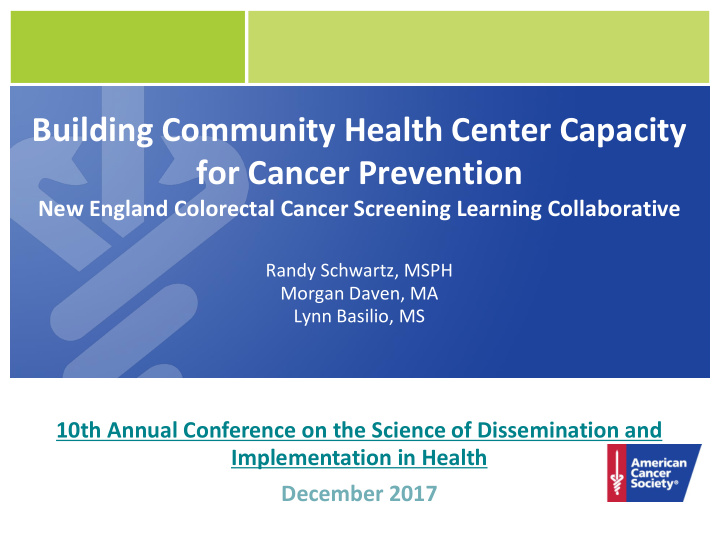



Building Community Health Center Capacity for Cancer Prevention New England Colorectal Cancer Screening Learning Collaborative Randy Schwartz, MSPH Morgan Daven, MA Lynn Basilio, MS 10th Annual Conference on the Science of Dissemination and Implementation in Health December 2017
American Cancer Society Health Systems Workforce • 600+ staff specializing in health systems partnerships • Six regional leadership teams • Partnerships to implement public health strategies and interventions • Focus on 3 system types: o Hospital systems CoC cancer centers Integrated delivery systems o State-based systems CDC, state health departments Health plans o Primary Care systems FQHCs, PCAs, NACHC, HRSA
American Cancer Society Primary Care Strategy • Build CHC capacity to help more patients and provide quality care • Collaborative • Team-based • Patient-centered • Evidence-based • Efficient • Sustainable • Relevant & appropriate
Adapting Evidence and Bringing to Scale
Adapting Evidence and Bringing to Scale
Adapting Evidence and Bringing to Scale
Quality Improvement Coaching ACS staff provide Quality Improvement coaching to ensure clinic policies, practices, and work-flows improve patient outcomes for cancer-related priorities. • Focus on interventions that have the greatest impact on ACS mission outcomes and are also aligned with CHC’s priorities. • Align interventions and support to PCMH standards. • Help develop Medical Neighborhood models (coordination of care). • Work with CHC QI staff to develop patient registries and implement rapid cycle improvement (PDSA cycles).
American Cancer Society Objectives Advance the national 80% by 2018 Colorectal Cancer Screening campaign in New England with primary care partners Engage multiple Health System partners in new Division-wide initiative Build Primary Care, Health Systems staff capacity in quality improvement activities through pilot project 8
Colorectal Cancer Screening Learning Collaborative 18-month pilot project involving 11 CHCs, 5 statewide partners, and ACS to increase CRC screening rates at CHCs Collaborative members met monthly (in-person or webinar) to learn, share, and discuss evidence-based interventions, quality improvement processes, and progress to goal Proposed evidence-based interventions – client reminder and recall systems; provider reminder and recall systems; and, provider assessment and feedback Baseline CRC screenings rates of 11 CHCs ranged from 34-60% CHCs reported data monthly; key measure included UDS CRC screening rate
Collaborative Members Community Health Centers Statewide Partners Charter Oak Health Center, CT Community Health Center Association of Connecticut Edward M Kennedy CHC, MA Maine Primary Care Association Fair Haven CHC, CT Massachusetts Department of Public Generations Family Health Center, CT Health Goodwin Community Health, NH Massachusetts League of Community HealthReach CHC, ME Health Centers Manchester CHC, NH New Hampshire Colorectal Cancer Nasson Health Care, ME Screening Program Penobscot CHC, ME Southwest CHC, CT WellOne Primary Medical & Dental Care, RI 10
Model for Improvement Always ask…. What can we do by next Tuesday?
Aim To increase colorectal cancer screening rates in the participating New England community health centers toward the national goal of 80% screening in the population age 50 and over by June 2016.
Changes Primary *Steps Identify clinical champion to lead Drivers Clarify roles of care team Step 1: Develop staff competency Make a Aim Prepared Establish team time, data collection Plan team Hold daily or 2x day huddles Look forward in schedule, identify who is Step 2: Patient due each week Increase Use reminders for those overdue Assemble a Identifica- colorectal Flag those due, bring to huddle Team tion cancer Use IT to identify patients screening Work down backlog Shared rates to 80% Offer patients a choice based on risk decision on or more Use risk guide first Step 3: Get among screen type Negotiate and set goal with patient Patients health Use Motivational Interviewing Screened center Overcome Use teach back for education patients Share gut check videos barriers, ages 50 and resistance, Support patient with care navigation, older by care coordination ambivalence June, 2016 Decide follow up vehicle (text, phone, Step 4: face to face, etc.) with patient Coordinate Communicate with specialists Referral and Improve relationships for referrals for GI Care Across follow specialists Continuum Communicate with colonoscopy up providers *As outlined in Steps for Increasing Colorectal Cancer Screening Rates: A Connect patients who need treatment Manual for Community Health Centers, ACS & National Colorectal Cancer with appropriate providers Roundtable
The PDSA Cycle for Learning and Improvement Plan Act Objective Adapt? Questions and Adopt ? predictions ( why) Abandon? Plan to carry out the cycle (who, what, where, when) Next cycle? Next cycle? Study Do Carry out the plan Complete the (on a small scale) analysis of the data Document problems Compare data to and unexpected predictions Summarize observations what Begin analysis was learned W.E.Deming referred to this as the Shewhart Cycle
CRC Screening Progress NE Colorectal Cancer Screening Learning Collaborative Aggregate Median CRC Screening Rates (N=11 health centers) May 2015-May 2016 75 70 65 60 Median Rate 55 50 45 40 35 30 25 May Aug Sep Oct Nov Dec Jan '16 Feb Mar Apr May '15 Median Rate 49.9 45.55 47.2 47 50 51.7 53.6 53.2 55 56 57.95 Baseline Median 47.1 47.1 47.1 47.1 Adjusted Median 53.4 53.4 53.4 53.4 53.4 53.4 53.4 Month
Breakthroughs Improved EHR/tracking system Provider reports/feedback Planning and team huddles Expanded FIT/FOBT testing
Barriers Lack of clinical champion/leadership EMR limitations and reporting issues Documentation Colonoscopy access and capacity Transient population
Lessons Learned Engage senior leadership and ensure a clinical champion participates actively on the improvement team Combining adaptations can build a scalable program Promote evidence-based practices and provide tailored support for testing and implementation Evidence-based models and tools can be adapted and utilized to scale Engage external champions and program developers Seek more input on data collection and reporting from CHC quality improvement staff
Building on the Collaborative ACS Cancer Control considering this model and scaling up in other regions ACS connecting with HRSA, NACHC, and other national partners to leverage resources and support for CHCs Exploring next Northeast Learning Collaborative – screening/disease area, geography, membership, staff capacity
Questions Thank you!
Recommend
More recommend